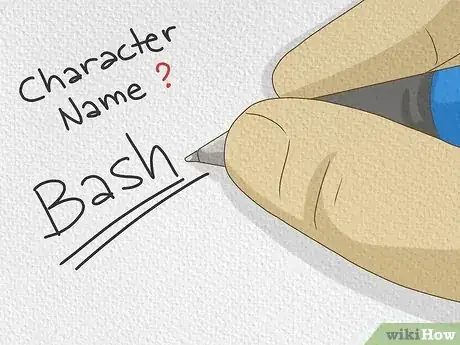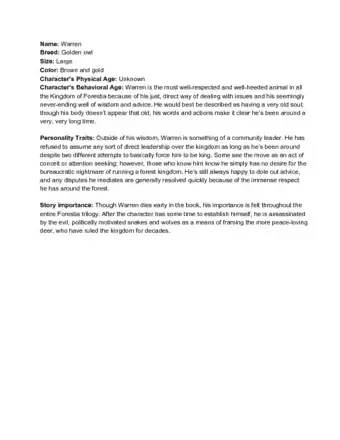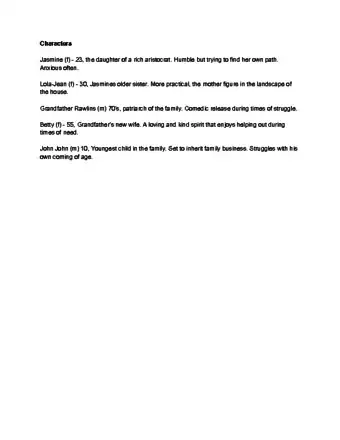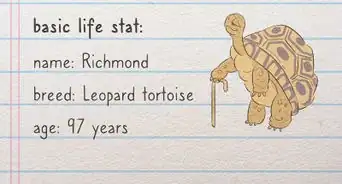This article was co-authored by Stephanie Wong Ken, MFA. Stephanie Wong Ken is a writer based in Canada. Stephanie's writing has appeared in Joyland, Catapult, Pithead Chapel, Cosmonaut's Avenue, and other publications. She holds an MFA in Fiction and Creative Writing from Portland State University.
wikiHow marks an article as reader-approved once it receives enough positive feedback. This article received 11 testimonials and 100% of readers who voted found it helpful, earning it our reader-approved status.
This article has been viewed 488,721 times.
Developing a character for a story can be a daunting task, as you want your character to feel real and detailed to your readers. A good fictional character will be believable and relatable, full of details that make them come alive. Start by describing the character’s physical characteristics, from their age to their hair color. Then, create the character’s backstory and determine their relationship to other characters in your story. You can then place your character into your story so they can live in the fictional world you have created.
Steps
Determining the Character’s Physical Characteristics
-
1Give your character a name. Pick a name that will suit the character and stick in your reader’s mind. You can decide if you want your character's name to tell you about the character or not.[1]
- For example, you might name a character “Sadie” because it is unique and suits the character’s demeanor. Or you may name your character “Bash” because they are bold and destructive in your story.
- You may want to choose unusual surnames like "Temples" or "Cottrill" so the name sticks in the reader's mind.
- In some cases, it’s easier to determine the other details of your character first and save their name for last. Perhaps your character's true identity could be revealed as the story progresses?
- Avoid choosing names too close to other characters. Readers may confuse them.
-
2Determine their age. Remember you may need to age your character if your story has a long time scale. Maybe your character is an adolescent, just two months shy of their sixteenth birthday. Or perhaps you are writing about an older character who has just celebrated their sixty-fifth birthday and is looking forward to retirement. Decide the approximate age of your character so you can create a unique and detailed voice for them in your story. After all, a character who is just a teenager will have a different point of view than a character who is decades older.[2]
- For example, you may determine that your character is twelve years old and just starting to experience puberty. You may then try to write from the perspective of a twelve-year old, using your own experiences at that age as inspiration.
Advertisement -
3Outline their appearance. Decide if your character is short, tall, skinny, muscular or stocky. Note if their eyes are blue, green, brown or grey. Maybe they have black hair or blonde hair with streaks of grey. Jot down a few notes about their physical appearance so you have a good idea of how they look. You can then use these details to build their character and make them come alive on the page.[3]
- For example, maybe your character is tall and lanky, with long, skinny arms and legs. They may have green eyes and dark colored hair, giving them a striking appearance.
- You can try sketching them.
-
4Note if they have any distinguishing physical traits. This could be a mole on the side of their face, a scar on their chest, or a limp when they walk. Giving your character a scar or other distinguishing mark can help them stand out on the page and become more memorable to your reader.[4]
- J.K. Rowling, for example, gave her main character a lightning bolt shaped scar, which is an interesting and memorable mark. Having a distinguishing mark play a role in your story makes it even more memorable.
- For example, you may have a character with a long scar behind their ear from an operation they had in their childhood. Or maybe your character has a tattoo on their back from a wild holiday.
-
5Describe the character’s clothing. Think about what the character wears on a daily basis to work or around the house. Decide if the character has a favorite or distinct item of clothing. Use the character’s style of dress to tell the reader a bit more about their personality.[5]
- For example, you may have a character who only wears black leather and denim to try to blend into the crowd. Or perhaps you have a character who dresses in designer clothing to show off their status and wealth.
-
6Determine the character’s race and/or nationality. Maybe your character is African-American or Hispanic. Perhaps your character is mixed-race, with one parent who is African and one parent who is Irish. Your character’s racial background may affect the way they view the world and how they interact with other characters.[6]
- For example, you may create a character that is Asian-American to reflect your own race or your family background.
- If you decide to create a character that is a race or nationality that is different than your own, be prepared to do research into that race or nationality to avoid falling into stereotypes.
Creating the Character’s Backstory
-
1Describe the character’s family. Outline whether the character has both parents who still live at home, or parents who are divorced. Maybe the character’s mother is now married to another man, or the character’s father is a widow and their mother died in their childhood. Also consider any siblings they have. Maybe your character is an only child and is close to cousins or has a particular group of friends. Maybe the character has five siblings and grew up in large family, but has a really close relationship with one sibling in particular, or is estranged from their eldest brother?[7]
- Don't forget about other familial relationships your character has. They may be really close to their uncle or their grandmother for instance.
-
2Explore where the character has lived or grown up. Provide backstory into the character’s home life and early experiences. Note where in the world the character was born and grew up. You can then use their home life to add details to their character, such as how they speak, how they express themselves, and how they view the world.[8]
- For example, maybe your character grew up in a deprived part of the American Deep South. They may then use certain vernacular and approach the world in a certain way.
-
3Outline the character’s schooling if applicable. Decide if your character went to high school and university or dropped out of education altogether. Determine if your character is currently at school and what grade or level they are in. Outlining your character’s schooling will tell the reader about your character’s education level.[9]
- You may have a character who did not finish school or dropped out and instead worked odd jobs to gain life experience. This could play into their character as a whole and their approach to the world.
-
4Determine their relationship status. Is your character single? Married? Divorced? In an open relationship? Maybe your character is involved with one of your other characters in the story, or with a minor character that only appears once. Determining their relationship status will help to clarify their interactions with other characters.[10]
- For example, you may have a character who is romantically involved with the other main character in your story. Or you may have a character who is recently divorced and trying to deal with the break-up of their marriage.
-
5Describe their likes and dislikes. Decide your character’s favorite color and favorite food. Make a list of their favorite television shows and films if applicable. If your story is set some time or place without TV shows and movies, you can disregard this (you could also consider what shows or movies your characters would like if TV/films existed). Determine what they do not like, such as food that make them gag or things that drive them insane such as: people who don't clean up after themselves, dogs, smokers etc. You can then use their likes and dislikes as features in your story.[11]
- For example, you may have a character who hates olives and loves tacos. Or, maybe your main character is obsessed with a television character and binge watches the same TV programme on repeat.
Giving the Character Motivation and Interiority
-
1Show how the character thinks. Give the character space in the story to think in their own voice. Write an internal monologue for the character so the reader gets a good sense of how the character perceives the world around them. Let your character have moments of introspection, where they muse or think through their ideas and thoughts.[12]
- For example, you may include moments of introspection like, “Sadie thought about how angry her mother would be when she got home, five minutes past her curfew. Would she confiscate her mobile phone again or just throw something at her head? Would she go on about how worthless and irresponsible she is? Maybe she fell asleep on pain pills again, dead to the world. Sadie crossed her fingers as she stepped inside.”
-
2Include dialogue that is specific to the character. Give the reader a sense of how the character speaks, including any slang or lingo they may use. Make the character’s voice unique and specific to their experiences as well as where they grew up. Tell the reader more about your character through their dialogue.[13]
- For example, you may have a character who speaks in a combination of English and Spanish to reflect their background and family life.
- You can also have a character who has a catchphrase that they say when they feel nervous, such as “Holy mother!” or “Seriously, dude.”
-
3Give the character a goal. A developed character will have a clear desire that motivates them to take action in the story. Their desire can be something seemingly small, such as wanting to ask someone out on a date. Or their goal can be large, such as wanting to save the world from mass destruction. Giving your character a desire or goal will ensure they are active in your story.[14]
- For example, your character may have a desire to leave their small town and escape their abusive family life. Or perhaps your character wants to learn how to throw a football correctly so they can join a local sports team.
-
4Create conflict for the character. Make your character’s life difficult so they can raise to the occasion and take action. Put obstacles in the way of your character’s desires or goals. The obstacles could be another character, a natural disaster, financial difficulties, or something else. This will create conflict and force your character to make decisions about what to do.[15]
- For example, your character may struggle to leave their lonesome, small town because they have to care for their elderly mother and have no money to go anywhere. Or your character may find it hard to throw a football because they cannot find someone to teach them how to do it properly.
-
5Allow the character to have flaws and make mistakes. Do not write a perfect character who gets exactly what they want and has no problems. This character will be boring and unrelatable to your readers (such characters are often called "Mary Sues". Give your character flaws and shortcomings. Have them make mistakes or bad decisions. Then, show your reader how they deal with their flaws and mistakes in the story.[16]
- For example, you may have a character who has addiction issues, causing them to lash out and hurt others around them. Or you may have a character who is too prideful to admit they are wrong, causing them to have poor relationships with their children. Your character could have a particular phobia, such as: heights, water, blood, large crowds or the dark. One of these could be holding them back from achieving their goals.
Sample Character Descriptions
References
- ↑ https://www.jtellison.com/how-to-build-a-character/
- ↑ https://www.writerswrite.com/journal/jun98/how-to-create-a-character-profile-6986
- ↑ https://www.writerswrite.com/journal/jun98/how-to-create-a-character-profile-6986
- ↑ http://education.seattlepi.com/develop-character-short-story-novel-4976.html
- ↑ https://www.writerswrite.com/journal/jun98/how-to-create-a-character-profile-6986
- ↑ https://www.writerswrite.com/journal/jun98/how-to-create-a-character-profile-6986
- ↑ https://www.writerswrite.com/journal/jun98/how-to-create-a-character-profile-6986
- ↑ https://www.writerswrite.com/journal/jun98/how-to-create-a-character-profile-6986
- ↑ http://education.seattlepi.com/develop-character-short-story-novel-4976.html
- ↑ http://education.seattlepi.com/develop-character-short-story-novel-4976.html
- ↑ http://www.writersdigest.com/writing-articles/by-writing-goal/improve-my-writing/8-ways-to-write-better-characters
- ↑ http://www.writersdigest.com/writing-articles/by-writing-goal/improve-my-writing/8-ways-to-write-better-characters
- ↑ http://www.nownovel.com/blog/character-development-tips/
- ↑ http://www.nownovel.com/blog/character-development-tips/
- ↑ http://www.nownovel.com/blog/character-development-tips/
- ↑ http://www.writersdigest.com/writing-articles/by-writing-goal/improve-my-writing/8-ways-to-write-better-characters
About This Article
To develop a character for a story you’re writing, start by giving them a name that suits the character and will stick in the reader's mind. Then, determine your character’s physical attributes, like height and eye color, and describe how they might dress, such as in jeans and t-shirts or designer clothes. Next, develop a backstory for your character that speaks to their family structure, childhood, and current relationship status. Finally, give your character goals, but create conflicts for them to work through to make the pursuit of those goals interesting. For tips from our English reviewer on how to reflect your character’s thoughts and feelings through internal monologue and dialogue, read on!


















































































